
Eucalyptus punctata, commonly known as grey gum, is a small to medium-sized tree that is endemic to eastern Australia. It has smooth grey bark that is shed in patches, lance-shaped, curved or egg-shaped adult leaves flower buds in groups of seven, white flowers and hemispherical or cup-shaped fruit. Its leaves are one of the favoured foods of the koala.

Eucalyptus radiata, commonly known as the narrow-leaved peppermint or Forth River peppermint, is a species of tree that is endemic to south-eastern Australia. It has rough, fibrous to flaky bark on the trunk and larger branches, smooth grey bark on the thinner branches, lance-shaped to curved or almost linear leaves, flower buds in groups of eleven to twenty or more, white flowers and cup-shaped, hemispherical or shortened spherical fruit.

Olearia pimeleoides, commonly known as pimelea daisy-bush, is a species of flowering plant in the family Asteraceae and is endemic to southern continental Australia. It is an erect shrub with elliptic, linear or lance-shaped leaves, and white and pale yellow, daisy-like inflorescences.

Pomaderris intermedia, commonly known as lemon dogwood, is a species of flowering plant in the family Rhamnaceae and is endemic to south-eastern Australia. It is a shrub with hairy stems, elliptic to egg-shaped leaves, and clusters of yellow flowers.
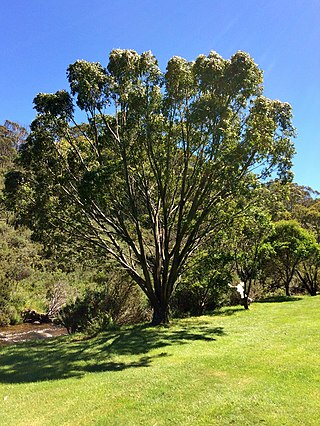
Eucalyptus stellulata, commonly known as black sallee or black sally, is a species of small tree or a mallee that is endemic to higher altitude regions of south-eastern Australia. it has rough bark on the lower part of the trunk smooth greenish bark above, lance-shaped to elliptical leaves, flower buds in group of between nine and fifteen, white flowers and cup-shaped or shortened spherical fruit.

Eucalyptus ligustrina, commonly known as the privet-leaved stringybark, is a species of shrub, mallee or small tree that is endemic to New South Wales. It has rough, stringy bark, lance-shaped to egg-shaped adult leaves, flower buds in groups of between seven and fifteen, white flowers and hemispherical or shortened spherical fruit.
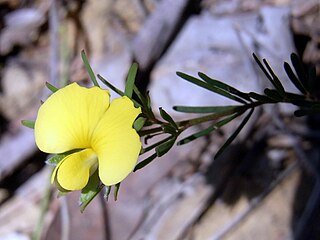
Gompholobium glabratum, commonly known as dainty wedge-pea, is a species of flowering plant in the family Fabaceae and is endemic to south-eastern continental Australia. It is a low-lying or ascending shrub with pinnate leaves that have five to seven leaflets, and yellow and green or greyish flowers.
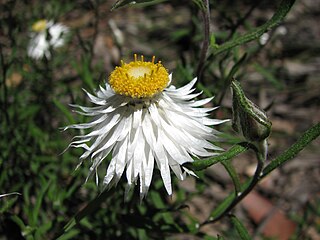
Helichrysum leucopsideum, commonly known as satin everlasting, is a flowering, perennial herb in the family Asteraceae. It is grows in all states of Australia except Queensland and the Northern Territory. It has white, terminal flower heads and narrow, woolly leaves.
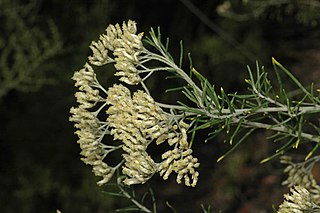
Cassinia uncata, commonly known as sticky cassinia, is a species of flowering plant in the family Asteraceae and is native to inland New South Wales and the south-east of South Australia. It is an erect shrub with hairy young stems, narrow linear to needle-shaped leaves, and heads of off-white to cream-coloured flowers arranged in rounded, almost conical panicles.

Persoonia trinervis is a species of flowering plant in the family Proteaceae and is endemic to the south-west of Western Australia. It is an erect, sometimes spreading shrub with densely hairy young branchlets, spatula-shaped or lance-shaped leaves with the narrower end towards the base, and densely hairy yellow flowers.

Persoonia sulcata is a plant in the family Proteaceae and is endemic to the south-west of Western Australia. It is a small, erect or low spreading shrub with narrow, linear leaves and cylindrical yellow flowers arranged singly or in groups of up to three in leaf axils. It grows in woodland or on rocky slopes and is found in several disjunct populations.
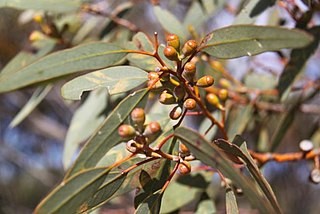
Eucalyptus obtusiflora, commonly known as Dongara mallee, is a species of mallee that is endemic to Western Australia. It has smooth greyish or brownish bark that is often imperfectly shed, lance-shaped to curved adult leaves, flower buds usually in groups of seven or nine, creamy white flowers and cup-shaped, conical or barrel-shaped fruit.
Eucalyptus remota, commonly known as the Kangaroo Island ash, Kangaroo Island mallee ash, or Mount Taylor mallee, is a species of tree or mallee that is endemic to Kangaroo Island in South Australia. It has smooth bark, often with rough, fibrous bark on the trunk, lance-shaped adult leaves, flower buds in group of between nine and twenty one, white flowers and hemispherical or shortened spherical fruit.

Olearia decurrens, commonly known as the clammy daisy bush, is a species of flowering plant in the family Asteraceae and is endemic to arid, inland Australia. It is a glabrous, sticky, twiggy shrub with narrow egg-shaped to linear leaves sometimes with toothed edges, and white and yellow, daisy-like inflorescences.

Leptospermum myrtifolium, commonly known as the myrtle tea-tree or grey tea-tree, is a species of shrub that is endemic to south eastern Australia. It has broad egg-shaped to elliptical leaves, white flowers usually borne singly on short side shoots, and fruit that remains on the plant until it dies.

Dillwynia rudis is a species of flowering plant in the family Fabaceae and is endemic to eastern New South Wales. It is an erect shrub with warty, linear leaves and yellow to orange flowers with red veins.

Podolobium scandens, commonly known as netted shaggy-pea, is a flowering plant in the family Fabaceae and is endemic to eastern Australia. It is a prostrate, small shrub with orange-yellow pea-like flowers and red markings.

Olearia quercifolia, commonly known as oak-leaved olearia, is a species of flowering plant in the family Asteraceae, and is endemic to the Blue Mountains in New South Wales. It is a shrub with elliptic to egg-shaped leaves with the narrower end towards the base, and white and yellow daisy flowers.

Olearia ramosissima, commonly known as much-branched daisy bush, is a species of flowering plant in the family Asteraceae and is endemic to continental Australia. It is a straggly shrub with densely-crowded, elliptic, egg-shaped or triangular leaves, and blue to violet and blue or yellow, daisy-like inflorescences.
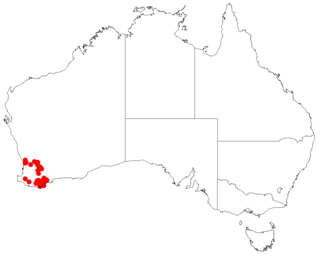
Leucopogon cymbiformis is a flowering plant in the family Ericaceae and is endemic to the south-west of Western Australia. It is a bushy or wiry shrub that typically grows to a height of 30–50 cm (12–20 in) and has more or less glabrous branches. Its leaves are erect, linear to lance-shaped and sharply-pointed, mostly 2–4 mm (0.079–0.157 in) long. The flowers are arranged in short spikes, sometimes of only two or three flowers, with lance-shaped, leaf-like bracts, and bracteoles half as long as the sepals at the base of the spikes. The sepals are 2.5–3.0 mm (0.098–0.118 in) long and the petals slightly longer than the sepals, the lobes shorter than the petal tube.

























